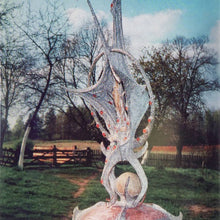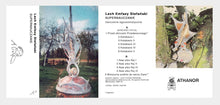Alicja / Poland / 2022
I can say about myself that I was programmed in my childhood, and then in my early youth. Like some artificial intelligence from a science-fiction novel.
Through the programming process, Lech Emfazy Stefański described a breakthrough moment in his youth. This led him to his most significant achievements, establishing in 1955 the famous Theater on Tarczyńska Street in Warsaw. It also contributed to the involvement in psychotronics - camouflage for occult and psychic activities, which was accepted by the authorities of late socialist Poland. This programming also became the ground from which grew the 16 cerebral hemispheric synchronization cassettes and his super-teaching practice.
I have gained a prize dear to my heart in dancing!
Stefański was fascinated by Suggestology of the Bulgarian researcher Georgy Lozanov. He practiced hypnosis himself and knew its limitations, so a less invasive method of influencing the human mind seemed attractive to him. After all, suggestion does not intimidate and enslave, but it can activate hidden forces and energy reserves. In order for the suggestion to be fruitful, it was necessary to introduce a person into "the mental state in which a person listening to a concert finds himself: into a state of inner relaxation, passivity, but also vigilance." Lozanov's research has shown that extraordinary abilities in a person are revealed at the rhythm of alpha brain waves (7-14 cycles per second). According to him, this state can be aroused by baroque music. The discoveries led to the popularization of audio materials on cassettes, which were used for meditation and awakening hidden potential.
Emfazy came with a tape recorder. (…) I stared into his eye, he into mine. He said it turned into different faces, that a window on the skin, I burst out laughing. I said his eye is getting a little bigger, he's moving forward. It has a dark rim. He said - No, no, no. But I checked that Emfazy has circles under his eyes without staring. (…) After the third turn taxiing in the head. Emfazy waited for action, then he was supposed to play the magical music of various peoples from the tape, for example the Korean flute, after which the sea calms down. (…) Lech Emfazy looked at his watch. - Well, it's late, it has a strange, vague effect on you (…) He took the briefcase, tape recorder. Like a doctor after a visit. Or a magician. He thanked me, I thanked him. Miron Białoszewski, Secret Diary, Wydawnictwo Znak, Kraków 2012, p. 314.
Stefanski was not satisfied with the products available on the market and decided to release his own series of tapes. And at this point history, which would probably remain an esoteric curiosity, makes a turn again. Stefański heads to the temple of new music and asks Krzysztof Szlifirski from the Studio Eksperymentalne Polskiego Radia for help. It provides him with audio material and detailed instructions. The engineer has to process the output recordings so that the phasing of the sound between the channels corresponds to the frequency that supports the synchronization of the hemispheres. Szlifirski describes the effects of this cooperation as an "accident at work".
a man wakes up
Each of the cassettes consists of two elements: an exercise part and a music-meditation part. Stefański was interested in creating hypnagogic images, i.e. hallucinations that are perceived on the threshold between wakefulness and sleep. Hence, the tapes contain surreal narratives that are supposed to lead the adept towards resonance with phasing. Cassettes should be listened to with headphones on a stereo set, because only then will the phasing be able to perform synchronization, which can enable, for example, rapid learning of foreign languages. Mind programming was to take on a new, universal form.
Emfazy came in. Dancing impossibly. With a helper also dancing. And as he began to speak, it turned out that his head was well organized.
Miron Białoszewski, Secret Diary, Wydawnictwo Znak, Kraków 2012, p. 450.
Who did the first programming that rearranged Stefanski's brain and allowed him to create his own conditioning mechanisms? This was the result of reading the writings of the writer, playwright and painter Stanisław Ignacy Witkiewicz, whose passion for psychoactive substances must have resonated with young Stefański. But the narrations recorded on the tapes are also his own vision of pure form, the experience of which is to lead to the use of the full spectrum of the human brain's capabilities.
did you stop dancing? - Daniel Muzyczuk
Through the programming process, Lech Emfazy Stefański described a breakthrough moment in his youth. This led him to his most significant achievements, establishing in 1955 the famous Theater on Tarczyńska Street in Warsaw. It also contributed to the involvement in psychotronics - camouflage for occult and psychic activities, which was accepted by the authorities of late socialist Poland. This programming also became the ground from which grew the 16 cerebral hemispheric synchronization cassettes and his super-teaching practice.
I have gained a prize dear to my heart in dancing!
Stefański was fascinated by Suggestology of the Bulgarian researcher Georgy Lozanov. He practiced hypnosis himself and knew its limitations, so a less invasive method of influencing the human mind seemed attractive to him. After all, suggestion does not intimidate and enslave, but it can activate hidden forces and energy reserves. In order for the suggestion to be fruitful, it was necessary to introduce a person into "the mental state in which a person listening to a concert finds himself: into a state of inner relaxation, passivity, but also vigilance." Lozanov's research has shown that extraordinary abilities in a person are revealed at the rhythm of alpha brain waves (7-14 cycles per second). According to him, this state can be aroused by baroque music. The discoveries led to the popularization of audio materials on cassettes, which were used for meditation and awakening hidden potential.
Emfazy came with a tape recorder. (…) I stared into his eye, he into mine. He said it turned into different faces, that a window on the skin, I burst out laughing. I said his eye is getting a little bigger, he's moving forward. It has a dark rim. He said - No, no, no. But I checked that Emfazy has circles under his eyes without staring. (…) After the third turn taxiing in the head. Emfazy waited for action, then he was supposed to play the magical music of various peoples from the tape, for example the Korean flute, after which the sea calms down. (…) Lech Emfazy looked at his watch. - Well, it's late, it has a strange, vague effect on you (…) He took the briefcase, tape recorder. Like a doctor after a visit. Or a magician. He thanked me, I thanked him. Miron Białoszewski, Secret Diary, Wydawnictwo Znak, Kraków 2012, p. 314.
Stefanski was not satisfied with the products available on the market and decided to release his own series of tapes. And at this point history, which would probably remain an esoteric curiosity, makes a turn again. Stefański heads to the temple of new music and asks Krzysztof Szlifirski from the Studio Eksperymentalne Polskiego Radia for help. It provides him with audio material and detailed instructions. The engineer has to process the output recordings so that the phasing of the sound between the channels corresponds to the frequency that supports the synchronization of the hemispheres. Szlifirski describes the effects of this cooperation as an "accident at work".
a man wakes up
Each of the cassettes consists of two elements: an exercise part and a music-meditation part. Stefański was interested in creating hypnagogic images, i.e. hallucinations that are perceived on the threshold between wakefulness and sleep. Hence, the tapes contain surreal narratives that are supposed to lead the adept towards resonance with phasing. Cassettes should be listened to with headphones on a stereo set, because only then will the phasing be able to perform synchronization, which can enable, for example, rapid learning of foreign languages. Mind programming was to take on a new, universal form.
Emfazy came in. Dancing impossibly. With a helper also dancing. And as he began to speak, it turned out that his head was well organized.
Miron Białoszewski, Secret Diary, Wydawnictwo Znak, Kraków 2012, p. 450.
Who did the first programming that rearranged Stefanski's brain and allowed him to create his own conditioning mechanisms? This was the result of reading the writings of the writer, playwright and painter Stanisław Ignacy Witkiewicz, whose passion for psychoactive substances must have resonated with young Stefański. But the narrations recorded on the tapes are also his own vision of pure form, the experience of which is to lead to the use of the full spectrum of the human brain's capabilities.
did you stop dancing? - Daniel Muzyczuk






